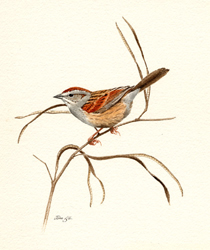Breeding Bird Atlases (BBA)
Find a Bird - BBA1
Breeding Bird Atlas 1 Species Accounts
Swamp Sparrow
Melospiza georgiana
Egg Dates
May 9 to July 18
Number of Broods
one or two

The Swamp Sparrow is a locally common resident of freshwater wetlands but is rare on the Cape and Islands. Historically, the agricultural practice of “reclaiming” wetlands in order to increase arable acreage adversely affected the Swamp Sparrow’s habitat. During this century, a significant amount of suitable nesting habitat has been lost to commercial real estate ventures and suburban development. Present-day Swamp Sparrow populations have benefited from recent attempts to preserve and protect the state’s wetlands.
In the springtime, usually by mid-April, Swamp Sparrows begin moving into our area from their more southerly wintering grounds. Transients continue to pass through during May. Resident males establish territories in various types of wetlands. Cattail marshes, swamps, river meadows, and pond edges are all favored residences of this species. In extensive habitat, nesting Swamp Sparrows can be numerous enough to give the impression of a loosely formed colony.
The Swamp Sparrow’s song consists of a musical trill given at one pitch. The rate is usually slow enough to allow the listener to distinguish between the individual notes. Typically, the male sings this song from a conspicuous perch in his territory. The song period often extends well into August. A sharp, metallic chink is a frequently used call note.
Swamp Sparrows build a well-concealed, bulky nest with a fine grass lining. The nest site may be in a tussock, among cattail flags, or in a shrub. In the Quaboag River marshes in Worcester County, nests typically were placed in bushes (ACB). Heights vary from a few inches from the water’s surface to 6 feet above the water level. When the nest is close to the water, late spring rains and flooding can disrupt the nesting cycle and result in renesting efforts. The clutch size is normally four to five (range three to six) eggs, which are incubated by the female for 12 to 13 days. Some pairs rear two broods per season. Little is known about Massachusetts nestings. In Worcester County, adults have been observed carrying food from June 2 to August 16 (Meservey).
From the latter part of summer to early October, local family groups and migrant Swamp Sparrows are observed regularly away from their normal haunts. At this time of the year, one is as likely to encounter this species in weed fields as in wetlands.
Although most Swamp Sparrows winter in states well to the south of our area, this species regularly overwinters locally in small numbers in suitable habitat. Southeastern coastal locales and inland river valleys with extensive areas of cattails or rushes often harbor small numbers of Swamp Sparrows in winter.
Map Legend and Data Summary
Atlas 1 data collected from 1975-1979


Note: fairly common in swamps, marshes, and wet meadows throughout most of state; scarcer on the Cape and Islands
Richard K. Walton



